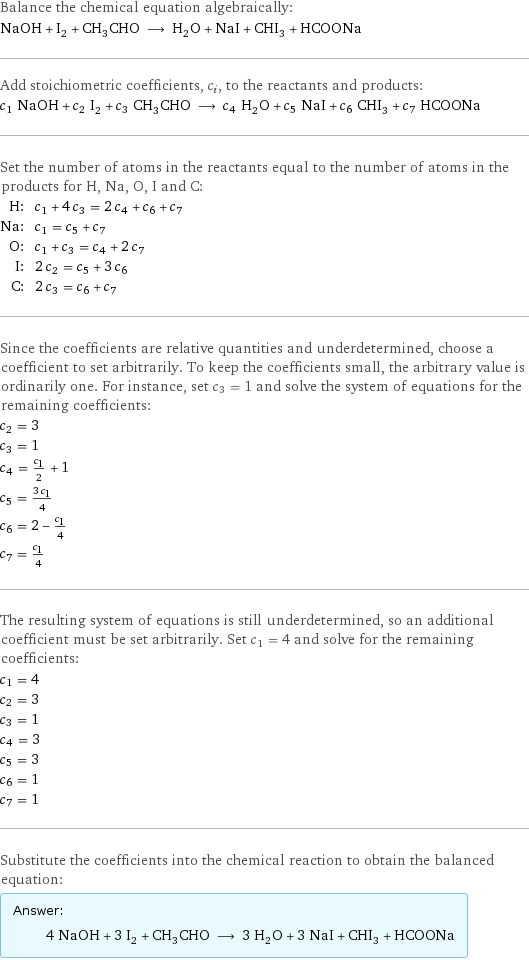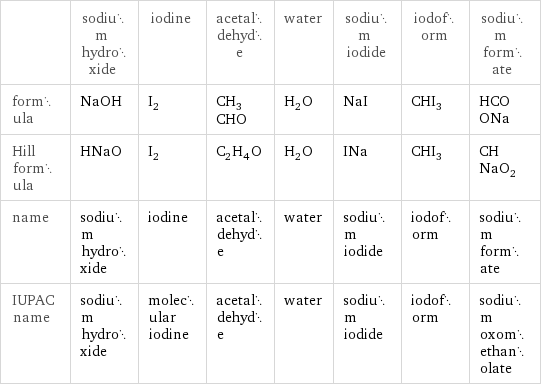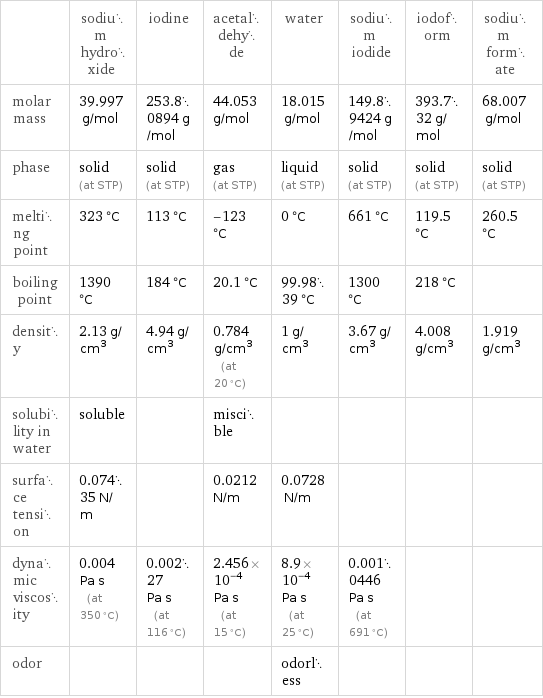Input interpretation

NaOH (sodium hydroxide) + I_2 (iodine) + CH_3CHO (acetaldehyde) ⟶ H_2O (water) + NaI (sodium iodide) + CHI_3 (iodoform) + HCOONa (sodium formate)
Balanced equation

Balance the chemical equation algebraically: NaOH + I_2 + CH_3CHO ⟶ H_2O + NaI + CHI_3 + HCOONa Add stoichiometric coefficients, c_i, to the reactants and products: c_1 NaOH + c_2 I_2 + c_3 CH_3CHO ⟶ c_4 H_2O + c_5 NaI + c_6 CHI_3 + c_7 HCOONa Set the number of atoms in the reactants equal to the number of atoms in the products for H, Na, O, I and C: H: | c_1 + 4 c_3 = 2 c_4 + c_6 + c_7 Na: | c_1 = c_5 + c_7 O: | c_1 + c_3 = c_4 + 2 c_7 I: | 2 c_2 = c_5 + 3 c_6 C: | 2 c_3 = c_6 + c_7 Since the coefficients are relative quantities and underdetermined, choose a coefficient to set arbitrarily. To keep the coefficients small, the arbitrary value is ordinarily one. For instance, set c_3 = 1 and solve the system of equations for the remaining coefficients: c_2 = 3 c_3 = 1 c_4 = c_1/2 + 1 c_5 = (3 c_1)/4 c_6 = 2 - c_1/4 c_7 = c_1/4 The resulting system of equations is still underdetermined, so an additional coefficient must be set arbitrarily. Set c_1 = 4 and solve for the remaining coefficients: c_1 = 4 c_2 = 3 c_3 = 1 c_4 = 3 c_5 = 3 c_6 = 1 c_7 = 1 Substitute the coefficients into the chemical reaction to obtain the balanced equation: Answer: | | 4 NaOH + 3 I_2 + CH_3CHO ⟶ 3 H_2O + 3 NaI + CHI_3 + HCOONa
Structures

+ + ⟶ + + +
Names

sodium hydroxide + iodine + acetaldehyde ⟶ water + sodium iodide + iodoform + sodium formate
Reaction thermodynamics
Enthalpy

| sodium hydroxide | iodine | acetaldehyde | water | sodium iodide | iodoform | sodium formate molecular enthalpy | -425.8 kJ/mol | 0 kJ/mol | -166.2 kJ/mol | -285.8 kJ/mol | -287.8 kJ/mol | -181.1 kJ/mol | -666.5 kJ/mol total enthalpy | -1703 kJ/mol | 0 kJ/mol | -166.2 kJ/mol | -857.5 kJ/mol | -863.4 kJ/mol | -181.1 kJ/mol | -666.5 kJ/mol | H_initial = -1869 kJ/mol | | | H_final = -2568 kJ/mol | | | ΔH_rxn^0 | -2568 kJ/mol - -1869 kJ/mol = -699.1 kJ/mol (exothermic) | | | | | |
Equilibrium constant
![Construct the equilibrium constant, K, expression for: NaOH + I_2 + CH_3CHO ⟶ H_2O + NaI + CHI_3 + HCOONa Plan: • Balance the chemical equation. • Determine the stoichiometric numbers. • Assemble the activity expression for each chemical species. • Use the activity expressions to build the equilibrium constant expression. Write the balanced chemical equation: 4 NaOH + 3 I_2 + CH_3CHO ⟶ 3 H_2O + 3 NaI + CHI_3 + HCOONa Assign stoichiometric numbers, ν_i, using the stoichiometric coefficients, c_i, from the balanced chemical equation in the following manner: ν_i = -c_i for reactants and ν_i = c_i for products: chemical species | c_i | ν_i NaOH | 4 | -4 I_2 | 3 | -3 CH_3CHO | 1 | -1 H_2O | 3 | 3 NaI | 3 | 3 CHI_3 | 1 | 1 HCOONa | 1 | 1 Assemble the activity expressions accounting for the state of matter and ν_i: chemical species | c_i | ν_i | activity expression NaOH | 4 | -4 | ([NaOH])^(-4) I_2 | 3 | -3 | ([I2])^(-3) CH_3CHO | 1 | -1 | ([CH3CHO])^(-1) H_2O | 3 | 3 | ([H2O])^3 NaI | 3 | 3 | ([NaI])^3 CHI_3 | 1 | 1 | [CHI3] HCOONa | 1 | 1 | [HCOONa] The equilibrium constant symbol in the concentration basis is: K_c Mulitply the activity expressions to arrive at the K_c expression: Answer: | | K_c = ([NaOH])^(-4) ([I2])^(-3) ([CH3CHO])^(-1) ([H2O])^3 ([NaI])^3 [CHI3] [HCOONa] = (([H2O])^3 ([NaI])^3 [CHI3] [HCOONa])/(([NaOH])^4 ([I2])^3 [CH3CHO])](../image_source/45a4ecbdafeb3b11a2d7e0896d9a9b0e.png)
Construct the equilibrium constant, K, expression for: NaOH + I_2 + CH_3CHO ⟶ H_2O + NaI + CHI_3 + HCOONa Plan: • Balance the chemical equation. • Determine the stoichiometric numbers. • Assemble the activity expression for each chemical species. • Use the activity expressions to build the equilibrium constant expression. Write the balanced chemical equation: 4 NaOH + 3 I_2 + CH_3CHO ⟶ 3 H_2O + 3 NaI + CHI_3 + HCOONa Assign stoichiometric numbers, ν_i, using the stoichiometric coefficients, c_i, from the balanced chemical equation in the following manner: ν_i = -c_i for reactants and ν_i = c_i for products: chemical species | c_i | ν_i NaOH | 4 | -4 I_2 | 3 | -3 CH_3CHO | 1 | -1 H_2O | 3 | 3 NaI | 3 | 3 CHI_3 | 1 | 1 HCOONa | 1 | 1 Assemble the activity expressions accounting for the state of matter and ν_i: chemical species | c_i | ν_i | activity expression NaOH | 4 | -4 | ([NaOH])^(-4) I_2 | 3 | -3 | ([I2])^(-3) CH_3CHO | 1 | -1 | ([CH3CHO])^(-1) H_2O | 3 | 3 | ([H2O])^3 NaI | 3 | 3 | ([NaI])^3 CHI_3 | 1 | 1 | [CHI3] HCOONa | 1 | 1 | [HCOONa] The equilibrium constant symbol in the concentration basis is: K_c Mulitply the activity expressions to arrive at the K_c expression: Answer: | | K_c = ([NaOH])^(-4) ([I2])^(-3) ([CH3CHO])^(-1) ([H2O])^3 ([NaI])^3 [CHI3] [HCOONa] = (([H2O])^3 ([NaI])^3 [CHI3] [HCOONa])/(([NaOH])^4 ([I2])^3 [CH3CHO])
Rate of reaction
![Construct the rate of reaction expression for: NaOH + I_2 + CH_3CHO ⟶ H_2O + NaI + CHI_3 + HCOONa Plan: • Balance the chemical equation. • Determine the stoichiometric numbers. • Assemble the rate term for each chemical species. • Write the rate of reaction expression. Write the balanced chemical equation: 4 NaOH + 3 I_2 + CH_3CHO ⟶ 3 H_2O + 3 NaI + CHI_3 + HCOONa Assign stoichiometric numbers, ν_i, using the stoichiometric coefficients, c_i, from the balanced chemical equation in the following manner: ν_i = -c_i for reactants and ν_i = c_i for products: chemical species | c_i | ν_i NaOH | 4 | -4 I_2 | 3 | -3 CH_3CHO | 1 | -1 H_2O | 3 | 3 NaI | 3 | 3 CHI_3 | 1 | 1 HCOONa | 1 | 1 The rate term for each chemical species, B_i, is 1/ν_i(Δ[B_i])/(Δt) where [B_i] is the amount concentration and t is time: chemical species | c_i | ν_i | rate term NaOH | 4 | -4 | -1/4 (Δ[NaOH])/(Δt) I_2 | 3 | -3 | -1/3 (Δ[I2])/(Δt) CH_3CHO | 1 | -1 | -(Δ[CH3CHO])/(Δt) H_2O | 3 | 3 | 1/3 (Δ[H2O])/(Δt) NaI | 3 | 3 | 1/3 (Δ[NaI])/(Δt) CHI_3 | 1 | 1 | (Δ[CHI3])/(Δt) HCOONa | 1 | 1 | (Δ[HCOONa])/(Δt) (for infinitesimal rate of change, replace Δ with d) Set the rate terms equal to each other to arrive at the rate expression: Answer: | | rate = -1/4 (Δ[NaOH])/(Δt) = -1/3 (Δ[I2])/(Δt) = -(Δ[CH3CHO])/(Δt) = 1/3 (Δ[H2O])/(Δt) = 1/3 (Δ[NaI])/(Δt) = (Δ[CHI3])/(Δt) = (Δ[HCOONa])/(Δt) (assuming constant volume and no accumulation of intermediates or side products)](../image_source/12be43891630496b601dee4e9610ca78.png)
Construct the rate of reaction expression for: NaOH + I_2 + CH_3CHO ⟶ H_2O + NaI + CHI_3 + HCOONa Plan: • Balance the chemical equation. • Determine the stoichiometric numbers. • Assemble the rate term for each chemical species. • Write the rate of reaction expression. Write the balanced chemical equation: 4 NaOH + 3 I_2 + CH_3CHO ⟶ 3 H_2O + 3 NaI + CHI_3 + HCOONa Assign stoichiometric numbers, ν_i, using the stoichiometric coefficients, c_i, from the balanced chemical equation in the following manner: ν_i = -c_i for reactants and ν_i = c_i for products: chemical species | c_i | ν_i NaOH | 4 | -4 I_2 | 3 | -3 CH_3CHO | 1 | -1 H_2O | 3 | 3 NaI | 3 | 3 CHI_3 | 1 | 1 HCOONa | 1 | 1 The rate term for each chemical species, B_i, is 1/ν_i(Δ[B_i])/(Δt) where [B_i] is the amount concentration and t is time: chemical species | c_i | ν_i | rate term NaOH | 4 | -4 | -1/4 (Δ[NaOH])/(Δt) I_2 | 3 | -3 | -1/3 (Δ[I2])/(Δt) CH_3CHO | 1 | -1 | -(Δ[CH3CHO])/(Δt) H_2O | 3 | 3 | 1/3 (Δ[H2O])/(Δt) NaI | 3 | 3 | 1/3 (Δ[NaI])/(Δt) CHI_3 | 1 | 1 | (Δ[CHI3])/(Δt) HCOONa | 1 | 1 | (Δ[HCOONa])/(Δt) (for infinitesimal rate of change, replace Δ with d) Set the rate terms equal to each other to arrive at the rate expression: Answer: | | rate = -1/4 (Δ[NaOH])/(Δt) = -1/3 (Δ[I2])/(Δt) = -(Δ[CH3CHO])/(Δt) = 1/3 (Δ[H2O])/(Δt) = 1/3 (Δ[NaI])/(Δt) = (Δ[CHI3])/(Δt) = (Δ[HCOONa])/(Δt) (assuming constant volume and no accumulation of intermediates or side products)
Chemical names and formulas

| sodium hydroxide | iodine | acetaldehyde | water | sodium iodide | iodoform | sodium formate formula | NaOH | I_2 | CH_3CHO | H_2O | NaI | CHI_3 | HCOONa Hill formula | HNaO | I_2 | C_2H_4O | H_2O | INa | CHI_3 | CHNaO_2 name | sodium hydroxide | iodine | acetaldehyde | water | sodium iodide | iodoform | sodium formate IUPAC name | sodium hydroxide | molecular iodine | acetaldehyde | water | sodium iodide | iodoform | sodium oxomethanolate
Substance properties

| sodium hydroxide | iodine | acetaldehyde | water | sodium iodide | iodoform | sodium formate molar mass | 39.997 g/mol | 253.80894 g/mol | 44.053 g/mol | 18.015 g/mol | 149.89424 g/mol | 393.732 g/mol | 68.007 g/mol phase | solid (at STP) | solid (at STP) | gas (at STP) | liquid (at STP) | solid (at STP) | solid (at STP) | solid (at STP) melting point | 323 °C | 113 °C | -123 °C | 0 °C | 661 °C | 119.5 °C | 260.5 °C boiling point | 1390 °C | 184 °C | 20.1 °C | 99.9839 °C | 1300 °C | 218 °C | density | 2.13 g/cm^3 | 4.94 g/cm^3 | 0.784 g/cm^3 (at 20 °C) | 1 g/cm^3 | 3.67 g/cm^3 | 4.008 g/cm^3 | 1.919 g/cm^3 solubility in water | soluble | | miscible | | | | surface tension | 0.07435 N/m | | 0.0212 N/m | 0.0728 N/m | | | dynamic viscosity | 0.004 Pa s (at 350 °C) | 0.00227 Pa s (at 116 °C) | 2.456×10^-4 Pa s (at 15 °C) | 8.9×10^-4 Pa s (at 25 °C) | 0.0010446 Pa s (at 691 °C) | | odor | | | | odorless | | |
Units
